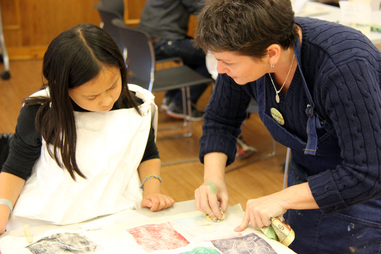Teaching Philosophy

Passion for the Arts and Learning
I love learning! I have a passion for books, researching, art, mediums, technology, software, hardware etc. I used to joke that I want to be a perpetual student when I grow up. As an educator I’m constantly learning new skills, maintaining my skills, and I’m most certainly learning every day from my students. I have a genuine enthusiasm, energy and drive for the arts; I hope my students find it contagious, motivating and stimulating. My mission in education is not only to be a mentor of the visual arts, but also to advocate for the arts.
The Four Components of Discipline Based Art Education
In each lesson plan I create I aspire to include all four components of Discipline-Based Art Education (DBAE):
art-making, art criticism, art history and aesthetics.
● Students make art using a variety of media, skills, tools, equipment, craftsmanship, experimentation, problem-solving and techniques.
● Students learn that art criticism encompasses describing, interpreting, analyzing and theorizing about works of art or art movements to better understand the artist’s intent.
● Students explore the art history of cultures and traditions to better understand an art object or art movement.
● Students are able to exam works of art aesthetically in order to question what makes something art.
DBAE insures a solid art curriculum consisting of a rigorous study of the arts that can be integrated into any curriculum.
Depending on the way a student learns, DBAE also takes into consideration Gardner’s Theory of Multiple Intelligences.
● The student who learns through shapes, images, patterns, design and texture. The actual act of art-making speaks to that student’s visual-spatial intelligence.
● The student who learns through recognition, appreciation and understanding will appreciate that art criticism speaks to this student’s natural intelligence.
● The student who learns through reading, writing and speaking will appreciate that art history speaks to this student’s verbal-linguistic intelligence.
● The student who learns through reflection, meaning, purpose and the significance of things will appreciate that aesthetics speaks to this student’s intrapersonal intelligence.
When crafting lesson plans I aspire to include a variety of multiple intelligences in an effort to reach all learners.
The Art Classroom:
I believe that the art classroom offers students an environment in which to experience learning that is unlike any academic classroom. The art classroom is a safe place where healthy connections with other students flourish; where interacting and collaborating is expected. Students find their voice, and discover that people are not only listening but are genuinely interested. This kind of positive feedback from teachers and students alike is liberating and powerful. As a result, students take more chances, explore, experiment, trust in themselves and gain self-confidence. When I think of the visual arts in the educational system my minds spins out of control with the unlimited skills it offers: art for art’s sake, life skills, 21st century skills, cognitive skills, multi-cultural understanding, personal and interpersonal connections.
I love learning! I have a passion for books, researching, art, mediums, technology, software, hardware etc. I used to joke that I want to be a perpetual student when I grow up. As an educator I’m constantly learning new skills, maintaining my skills, and I’m most certainly learning every day from my students. I have a genuine enthusiasm, energy and drive for the arts; I hope my students find it contagious, motivating and stimulating. My mission in education is not only to be a mentor of the visual arts, but also to advocate for the arts.
The Four Components of Discipline Based Art Education
In each lesson plan I create I aspire to include all four components of Discipline-Based Art Education (DBAE):
art-making, art criticism, art history and aesthetics.
● Students make art using a variety of media, skills, tools, equipment, craftsmanship, experimentation, problem-solving and techniques.
● Students learn that art criticism encompasses describing, interpreting, analyzing and theorizing about works of art or art movements to better understand the artist’s intent.
● Students explore the art history of cultures and traditions to better understand an art object or art movement.
● Students are able to exam works of art aesthetically in order to question what makes something art.
DBAE insures a solid art curriculum consisting of a rigorous study of the arts that can be integrated into any curriculum.
Depending on the way a student learns, DBAE also takes into consideration Gardner’s Theory of Multiple Intelligences.
● The student who learns through shapes, images, patterns, design and texture. The actual act of art-making speaks to that student’s visual-spatial intelligence.
● The student who learns through recognition, appreciation and understanding will appreciate that art criticism speaks to this student’s natural intelligence.
● The student who learns through reading, writing and speaking will appreciate that art history speaks to this student’s verbal-linguistic intelligence.
● The student who learns through reflection, meaning, purpose and the significance of things will appreciate that aesthetics speaks to this student’s intrapersonal intelligence.
When crafting lesson plans I aspire to include a variety of multiple intelligences in an effort to reach all learners.
The Art Classroom:
I believe that the art classroom offers students an environment in which to experience learning that is unlike any academic classroom. The art classroom is a safe place where healthy connections with other students flourish; where interacting and collaborating is expected. Students find their voice, and discover that people are not only listening but are genuinely interested. This kind of positive feedback from teachers and students alike is liberating and powerful. As a result, students take more chances, explore, experiment, trust in themselves and gain self-confidence. When I think of the visual arts in the educational system my minds spins out of control with the unlimited skills it offers: art for art’s sake, life skills, 21st century skills, cognitive skills, multi-cultural understanding, personal and interpersonal connections.
Workshop at the Institute of Contemporary Art , Portland, ME
